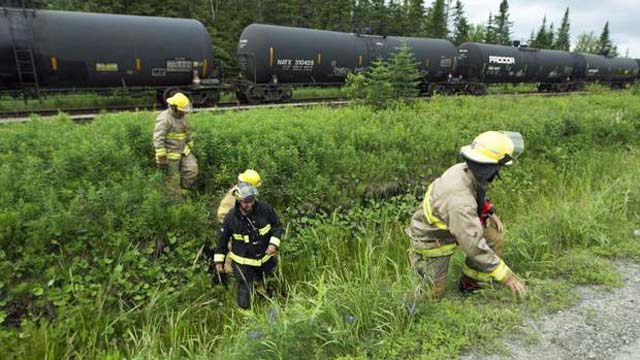

Firefighters in Nantes, Quebec, inspect a row of oil tankers sitting on a railway siding - 10 Jul 2013 Peter Power.
24 July 2013 MM&A Regularly Left Loaded Trains Unsupervised Using Siding Track for Storage Lake Megantic Quebec - The U.S.-based company whose train derailed in Lake Megantic regularly left loaded trains unsupervised on the main line so it could use the more secure siding as a storage space for a local manufacturer's unused rail cars.
Montreal Maine & Atlantic used a railway siding in Nantes to store rail cars set aside for Tafisa, a particle board manufacturer located in Lake Megantic's industrial park. The practice did not contravene any safety regulations, but it meant MM&A engineers were unable to pull onto the siding when parking trains during a crew change.
The Transportation Safety Board is still investigating what caused an MM&A train to begin rolling down the track from Nantes on 6 Jul 2013. The train picked up speed on a downhill slope and jumped the track after about 10 kilometres, setting off a series of fiery explosions that destroyed downtown Lake Megantic and killed an estimated 47 people.
But a growing body of evidence suggests several factors may have contributed to the crash, including MM&A's practice of leaving trains unattended on the main line instead of moving them onto the siding, a stretch of parallel track equipped with a large metal derailer that is designed to push the front of the train off the tracks and stop it from moving farther.
Transport Canada issued an "emergency directive" this week requiring railways to ensure that trains carrying hazardous goods are moved off the main tracks, among a series of other changes. The new policies were introduced days after TSB investigators in Lake Megantic warned federal regulators that there were no rules against the practice.
Before the crash, MM&A used two sidings to serve the Tafisa, one in Nantes, and another to the east of Lake Megantic, located near the border with the United States. The company's CEO, Louis Brassard, told The Globe and Mail that the sidings are used as "parking lots" for cars the company isn't using.
Every week until the 6 Jul 2013 derailment, between 50 and 60 rail cars were slowly driven inside the sprawling Tafisa complex, located in an industrial park east of downtown Lake Megantic, and loaded with tonnes of particle board and melamine. The factory's finished product was then shipped west, bound for Montreal and other North American markets.
"We load the trains seven days a week," said Mr. Brassard, explaining why the railway kept a steady supply of empty cars near the factory.
MM&A chairman Edward Burkhardt has cast blame on the train's engineer for the Lake Megantic accident, saying he believes the employee failed to set enough hand brakes to hold it in place once the air brakes failed. But railway experts say the siding could have provided another layer of protection, if the company had made use of it.
"If their practice had been to store it on a siding with the derail installed, this never would have happened," said Wayne Benedict, a former locomotive engineer with CP Rail and BC Rail.
"No matter how many hand brakes were, or were not, put on there, when the pneumatic braking system failed and the hand brakes failed to hold the equipment, it would have just plopped off the derail at the east end of Nantes and that would have been an end to it."
Mr. Burkhardt could not be reached for comment on Wednesday. But earlier this week, he told The Globe and Mail that MM&A would no longer leave any of its trains, including those carrying dangerous goods, on the main tracks without supervision.
On Wednesday, a rusted yellow derailer sat clamped on the siding in Nantes, with a large yellow warning sign planted in the gravel nearby. Farther back, nearly two-dozen boxcars remained in the same location on the siding where they have been since the crash. Mr. Brassard said the cars were scheduled to come to the Tafisa factory for loading but Quebec provincial police have not allowed them to be moved.
Kim MacKrael and Justin Giovannetti.



Vancouver Island
British Columbia
Canada
| 
